BIZ304 - Business Consulting Report: Qantas Domestic Strategies
VerifiedAdded on 2023/04/06
|9
|1402
|493
Report
AI Summary
This business consulting report addresses Qantas' need to expand its market size and share within the Australian domestic airline industry. The project scope includes identifying a new domestic route and implementing strategic partnerships (excluding other airlines) to achieve this goal. The report details the project's deliverables, exclusions, and constraints, including understanding potential partner's internal issues. It presents an industry analysis using Porter's Five Forces, highlighting barriers to entry, supplier and buyer power, the availability of substitutes, and competitive rivalry. The analysis concludes that Qantas is well-positioned regarding barriers to entry and competition, but opportunities exist to improve business operations and form strategic partnerships with complementary businesses to further expand the market size.
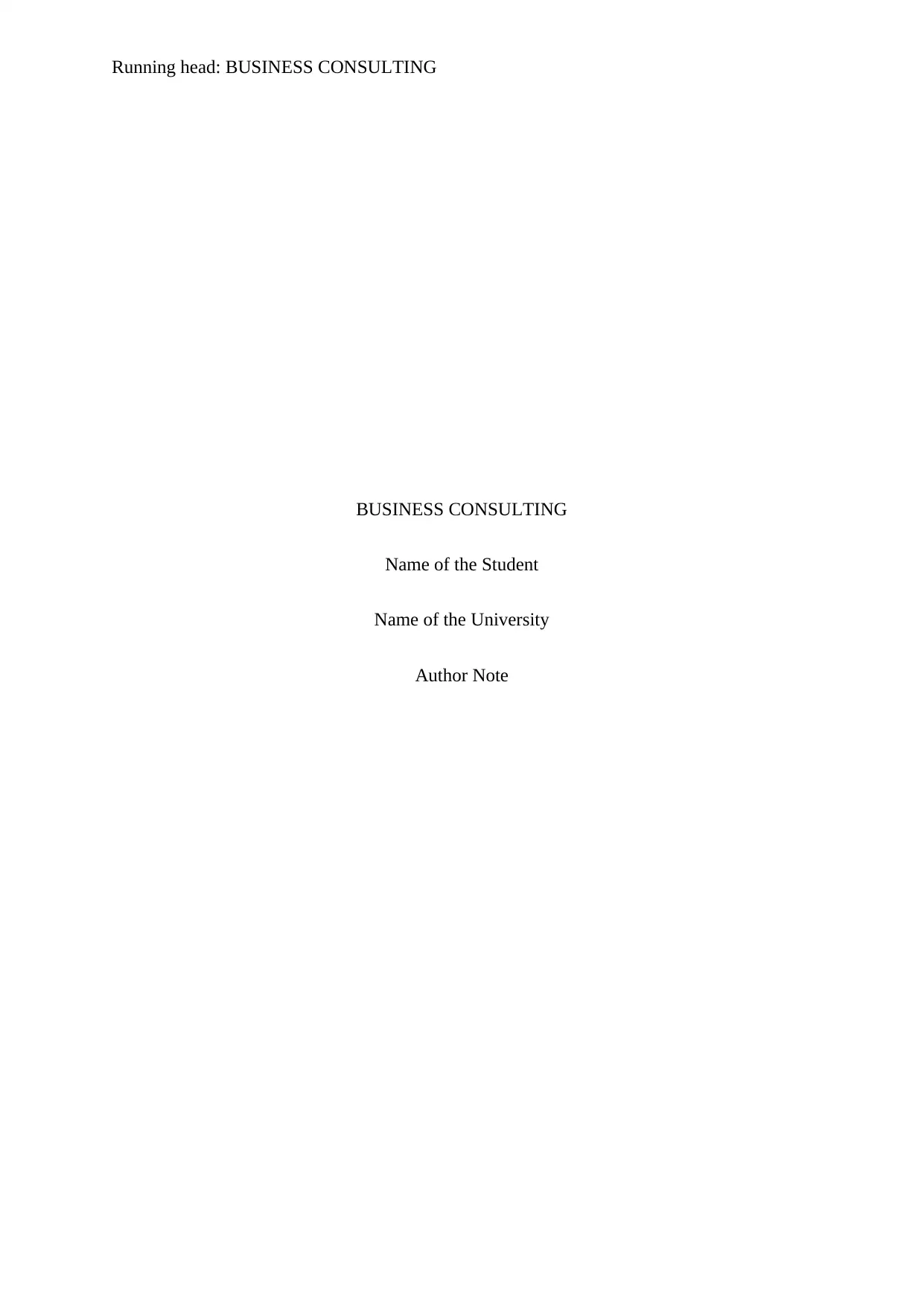
Running head: BUSINESS CONSULTING
BUSINESS CONSULTING
Name of the Student
Name of the University
Author Note
BUSINESS CONSULTING
Name of the Student
Name of the University
Author Note
Paraphrase This Document
Need a fresh take? Get an instant paraphrase of this document with our AI Paraphraser
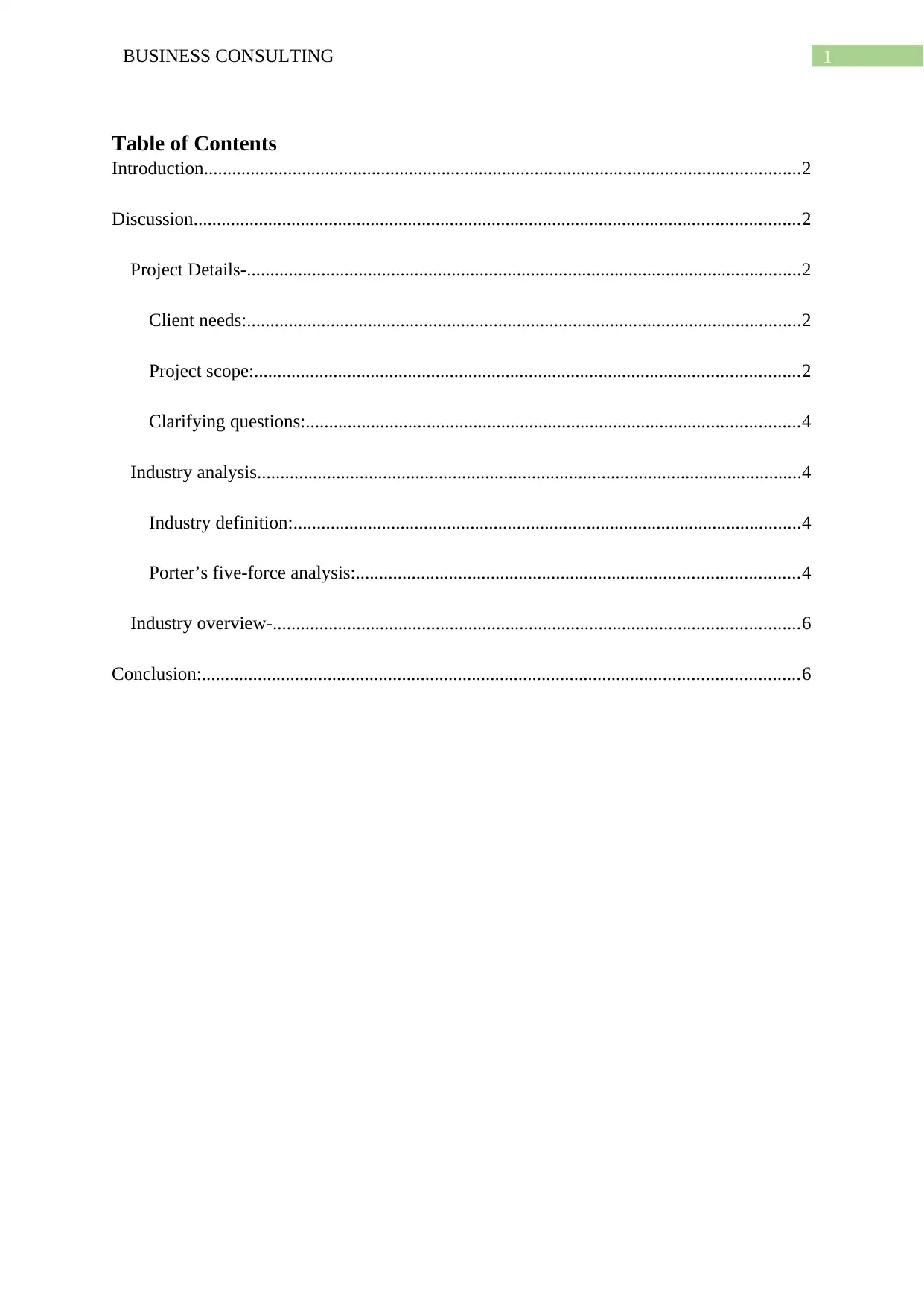
1BUSINESS CONSULTING
Table of Contents
Introduction................................................................................................................................2
Discussion..................................................................................................................................2
Project Details-.......................................................................................................................2
Client needs:.......................................................................................................................2
Project scope:.....................................................................................................................2
Clarifying questions:..........................................................................................................4
Industry analysis.....................................................................................................................4
Industry definition:.............................................................................................................4
Porter’s five-force analysis:...............................................................................................4
Industry overview-.................................................................................................................6
Conclusion:................................................................................................................................6
Table of Contents
Introduction................................................................................................................................2
Discussion..................................................................................................................................2
Project Details-.......................................................................................................................2
Client needs:.......................................................................................................................2
Project scope:.....................................................................................................................2
Clarifying questions:..........................................................................................................4
Industry analysis.....................................................................................................................4
Industry definition:.............................................................................................................4
Porter’s five-force analysis:...............................................................................................4
Industry overview-.................................................................................................................6
Conclusion:................................................................................................................................6
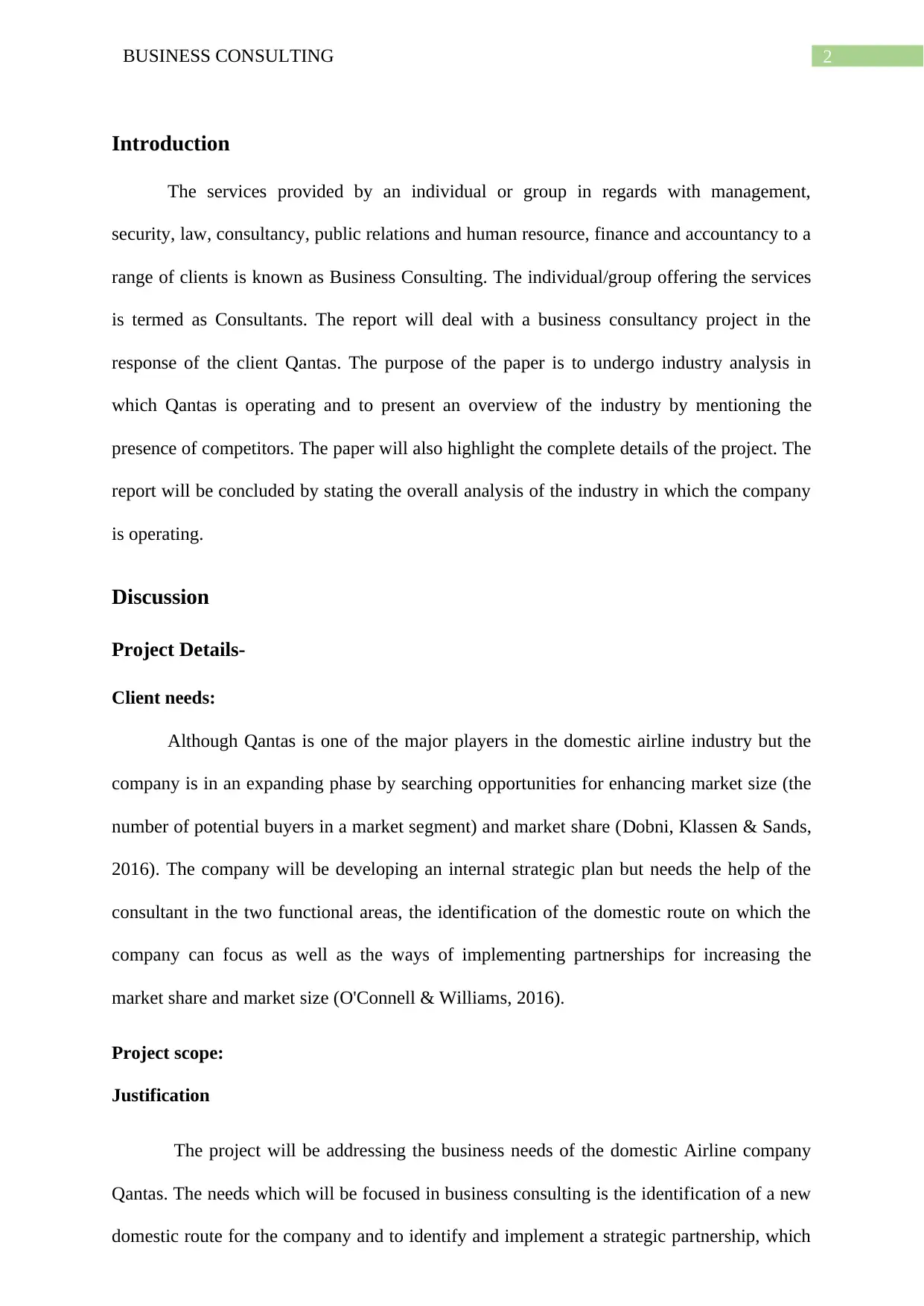
2BUSINESS CONSULTING
Introduction
The services provided by an individual or group in regards with management,
security, law, consultancy, public relations and human resource, finance and accountancy to a
range of clients is known as Business Consulting. The individual/group offering the services
is termed as Consultants. The report will deal with a business consultancy project in the
response of the client Qantas. The purpose of the paper is to undergo industry analysis in
which Qantas is operating and to present an overview of the industry by mentioning the
presence of competitors. The paper will also highlight the complete details of the project. The
report will be concluded by stating the overall analysis of the industry in which the company
is operating.
Discussion
Project Details-
Client needs:
Although Qantas is one of the major players in the domestic airline industry but the
company is in an expanding phase by searching opportunities for enhancing market size (the
number of potential buyers in a market segment) and market share (Dobni, Klassen & Sands,
2016). The company will be developing an internal strategic plan but needs the help of the
consultant in the two functional areas, the identification of the domestic route on which the
company can focus as well as the ways of implementing partnerships for increasing the
market share and market size (O'Connell & Williams, 2016).
Project scope:
Justification
The project will be addressing the business needs of the domestic Airline company
Qantas. The needs which will be focused in business consulting is the identification of a new
domestic route for the company and to identify and implement a strategic partnership, which
Introduction
The services provided by an individual or group in regards with management,
security, law, consultancy, public relations and human resource, finance and accountancy to a
range of clients is known as Business Consulting. The individual/group offering the services
is termed as Consultants. The report will deal with a business consultancy project in the
response of the client Qantas. The purpose of the paper is to undergo industry analysis in
which Qantas is operating and to present an overview of the industry by mentioning the
presence of competitors. The paper will also highlight the complete details of the project. The
report will be concluded by stating the overall analysis of the industry in which the company
is operating.
Discussion
Project Details-
Client needs:
Although Qantas is one of the major players in the domestic airline industry but the
company is in an expanding phase by searching opportunities for enhancing market size (the
number of potential buyers in a market segment) and market share (Dobni, Klassen & Sands,
2016). The company will be developing an internal strategic plan but needs the help of the
consultant in the two functional areas, the identification of the domestic route on which the
company can focus as well as the ways of implementing partnerships for increasing the
market share and market size (O'Connell & Williams, 2016).
Project scope:
Justification
The project will be addressing the business needs of the domestic Airline company
Qantas. The needs which will be focused in business consulting is the identification of a new
domestic route for the company and to identify and implement a strategic partnership, which
⊘ This is a preview!⊘
Do you want full access?
Subscribe today to unlock all pages.

Trusted by 1+ million students worldwide
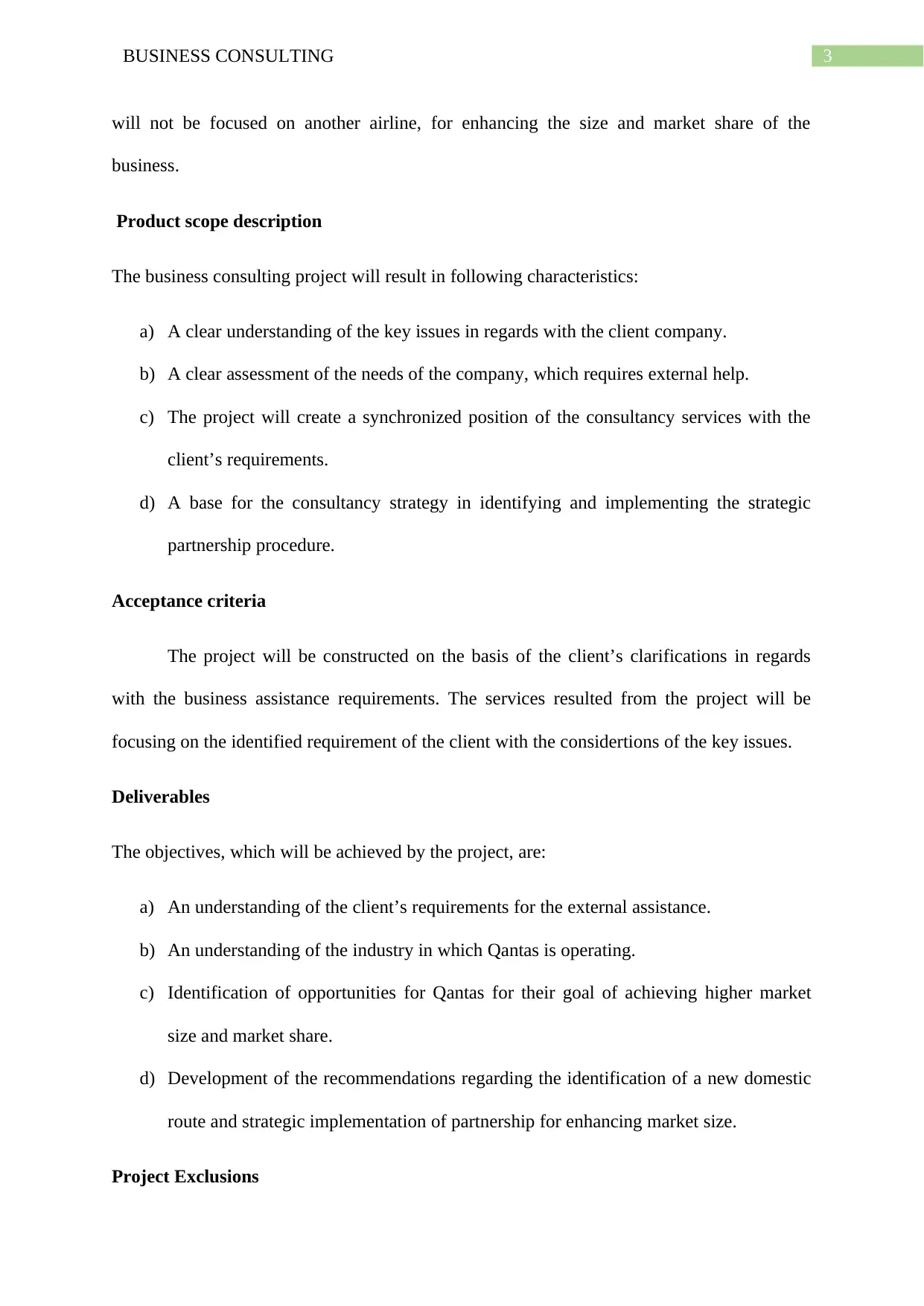
3BUSINESS CONSULTING
will not be focused on another airline, for enhancing the size and market share of the
business.
Product scope description
The business consulting project will result in following characteristics:
a) A clear understanding of the key issues in regards with the client company.
b) A clear assessment of the needs of the company, which requires external help.
c) The project will create a synchronized position of the consultancy services with the
client’s requirements.
d) A base for the consultancy strategy in identifying and implementing the strategic
partnership procedure.
Acceptance criteria
The project will be constructed on the basis of the client’s clarifications in regards
with the business assistance requirements. The services resulted from the project will be
focusing on the identified requirement of the client with the considertions of the key issues.
Deliverables
The objectives, which will be achieved by the project, are:
a) An understanding of the client’s requirements for the external assistance.
b) An understanding of the industry in which Qantas is operating.
c) Identification of opportunities for Qantas for their goal of achieving higher market
size and market share.
d) Development of the recommendations regarding the identification of a new domestic
route and strategic implementation of partnership for enhancing market size.
Project Exclusions
will not be focused on another airline, for enhancing the size and market share of the
business.
Product scope description
The business consulting project will result in following characteristics:
a) A clear understanding of the key issues in regards with the client company.
b) A clear assessment of the needs of the company, which requires external help.
c) The project will create a synchronized position of the consultancy services with the
client’s requirements.
d) A base for the consultancy strategy in identifying and implementing the strategic
partnership procedure.
Acceptance criteria
The project will be constructed on the basis of the client’s clarifications in regards
with the business assistance requirements. The services resulted from the project will be
focusing on the identified requirement of the client with the considertions of the key issues.
Deliverables
The objectives, which will be achieved by the project, are:
a) An understanding of the client’s requirements for the external assistance.
b) An understanding of the industry in which Qantas is operating.
c) Identification of opportunities for Qantas for their goal of achieving higher market
size and market share.
d) Development of the recommendations regarding the identification of a new domestic
route and strategic implementation of partnership for enhancing market size.
Project Exclusions
Paraphrase This Document
Need a fresh take? Get an instant paraphrase of this document with our AI Paraphraser
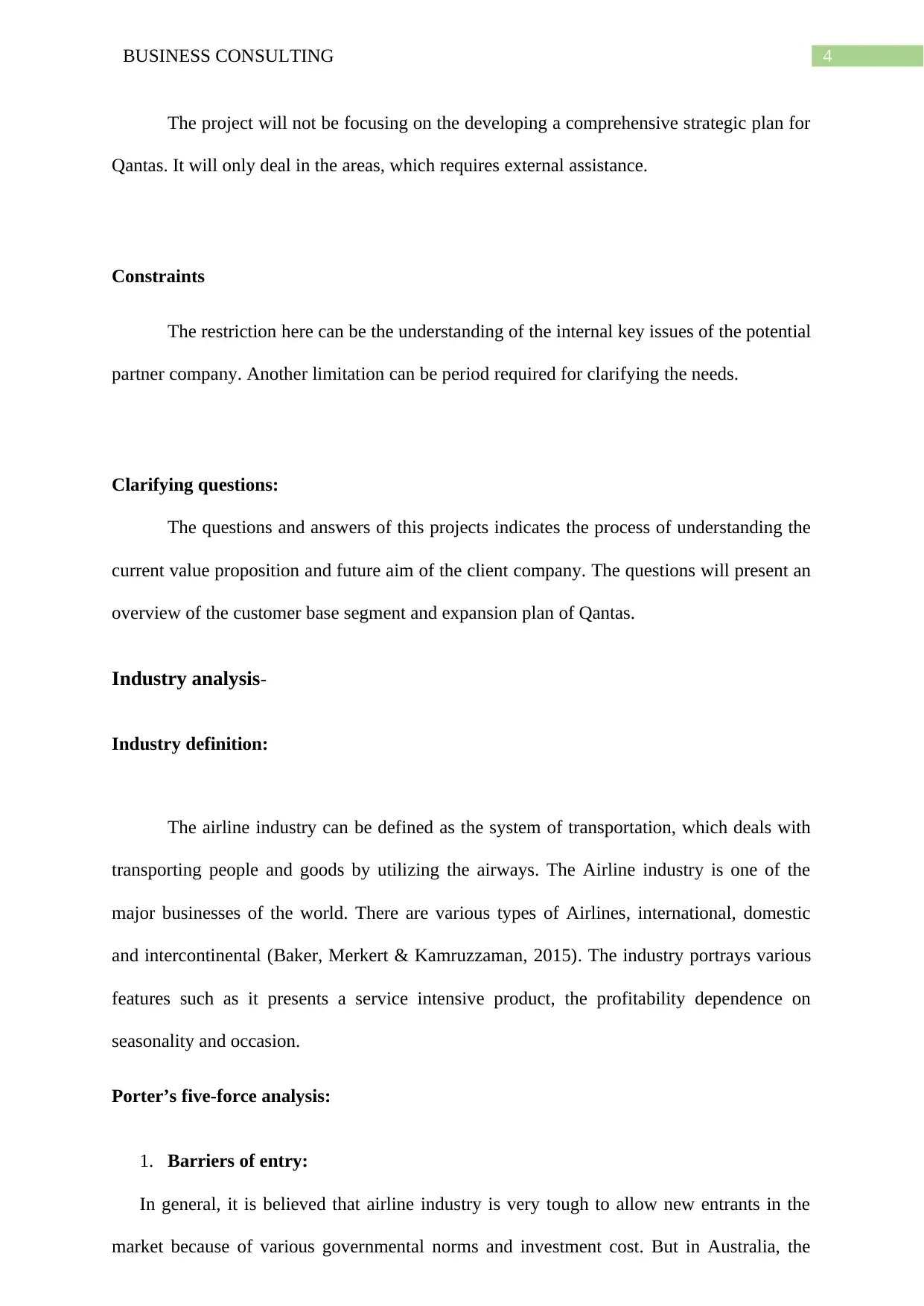
4BUSINESS CONSULTING
The project will not be focusing on the developing a comprehensive strategic plan for
Qantas. It will only deal in the areas, which requires external assistance.
Constraints
The restriction here can be the understanding of the internal key issues of the potential
partner company. Another limitation can be period required for clarifying the needs.
Clarifying questions:
The questions and answers of this projects indicates the process of understanding the
current value proposition and future aim of the client company. The questions will present an
overview of the customer base segment and expansion plan of Qantas.
Industry analysis-
Industry definition:
The airline industry can be defined as the system of transportation, which deals with
transporting people and goods by utilizing the airways. The Airline industry is one of the
major businesses of the world. There are various types of Airlines, international, domestic
and intercontinental (Baker, Merkert & Kamruzzaman, 2015). The industry portrays various
features such as it presents a service intensive product, the profitability dependence on
seasonality and occasion.
Porter’s five-force analysis:
1. Barriers of entry:
In general, it is believed that airline industry is very tough to allow new entrants in the
market because of various governmental norms and investment cost. But in Australia, the
The project will not be focusing on the developing a comprehensive strategic plan for
Qantas. It will only deal in the areas, which requires external assistance.
Constraints
The restriction here can be the understanding of the internal key issues of the potential
partner company. Another limitation can be period required for clarifying the needs.
Clarifying questions:
The questions and answers of this projects indicates the process of understanding the
current value proposition and future aim of the client company. The questions will present an
overview of the customer base segment and expansion plan of Qantas.
Industry analysis-
Industry definition:
The airline industry can be defined as the system of transportation, which deals with
transporting people and goods by utilizing the airways. The Airline industry is one of the
major businesses of the world. There are various types of Airlines, international, domestic
and intercontinental (Baker, Merkert & Kamruzzaman, 2015). The industry portrays various
features such as it presents a service intensive product, the profitability dependence on
seasonality and occasion.
Porter’s five-force analysis:
1. Barriers of entry:
In general, it is believed that airline industry is very tough to allow new entrants in the
market because of various governmental norms and investment cost. But in Australia, the
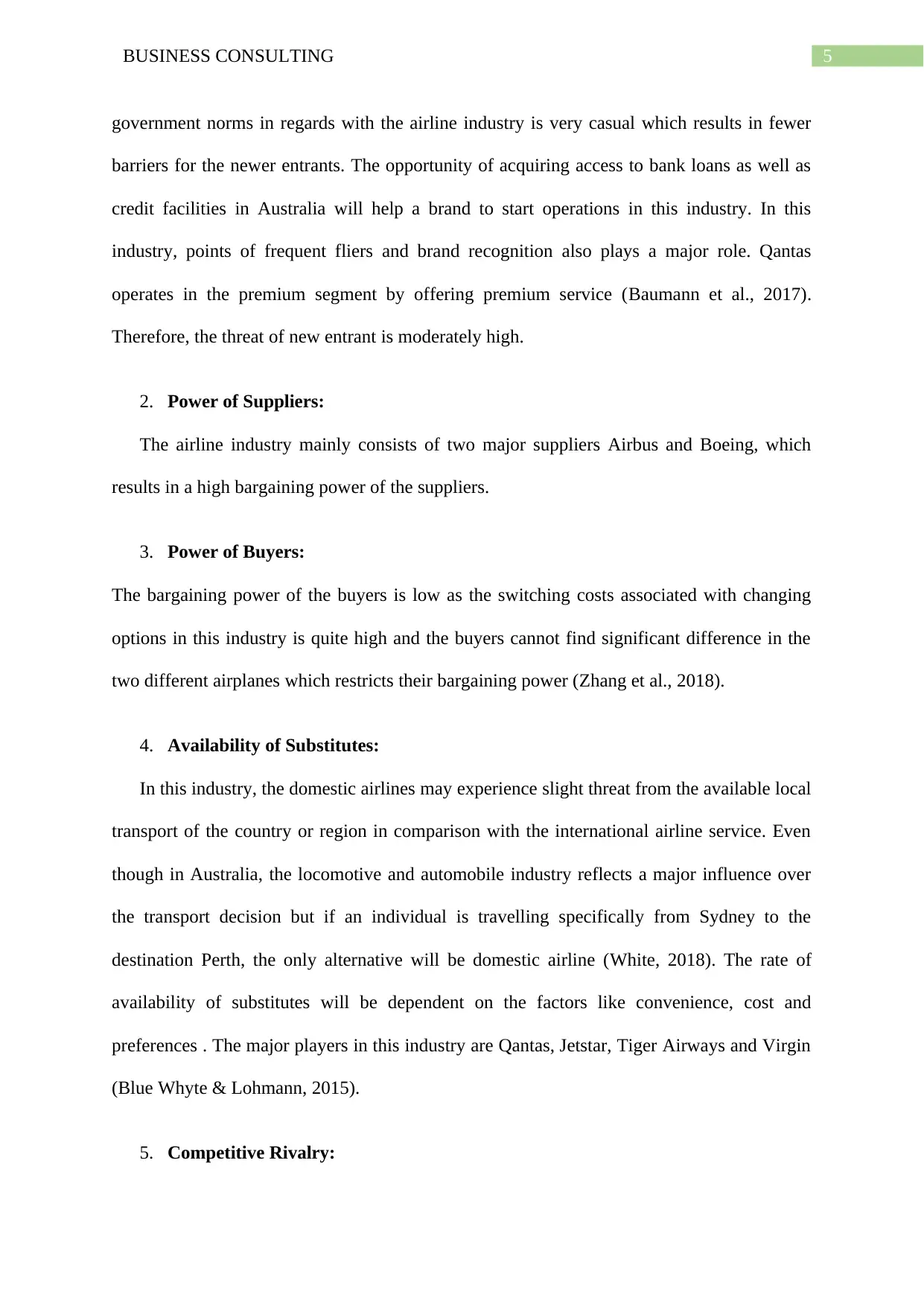
5BUSINESS CONSULTING
government norms in regards with the airline industry is very casual which results in fewer
barriers for the newer entrants. The opportunity of acquiring access to bank loans as well as
credit facilities in Australia will help a brand to start operations in this industry. In this
industry, points of frequent fliers and brand recognition also plays a major role. Qantas
operates in the premium segment by offering premium service (Baumann et al., 2017).
Therefore, the threat of new entrant is moderately high.
2. Power of Suppliers:
The airline industry mainly consists of two major suppliers Airbus and Boeing, which
results in a high bargaining power of the suppliers.
3. Power of Buyers:
The bargaining power of the buyers is low as the switching costs associated with changing
options in this industry is quite high and the buyers cannot find significant difference in the
two different airplanes which restricts their bargaining power (Zhang et al., 2018).
4. Availability of Substitutes:
In this industry, the domestic airlines may experience slight threat from the available local
transport of the country or region in comparison with the international airline service. Even
though in Australia, the locomotive and automobile industry reflects a major influence over
the transport decision but if an individual is travelling specifically from Sydney to the
destination Perth, the only alternative will be domestic airline (White, 2018). The rate of
availability of substitutes will be dependent on the factors like convenience, cost and
preferences . The major players in this industry are Qantas, Jetstar, Tiger Airways and Virgin
(Blue Whyte & Lohmann, 2015).
5. Competitive Rivalry:
government norms in regards with the airline industry is very casual which results in fewer
barriers for the newer entrants. The opportunity of acquiring access to bank loans as well as
credit facilities in Australia will help a brand to start operations in this industry. In this
industry, points of frequent fliers and brand recognition also plays a major role. Qantas
operates in the premium segment by offering premium service (Baumann et al., 2017).
Therefore, the threat of new entrant is moderately high.
2. Power of Suppliers:
The airline industry mainly consists of two major suppliers Airbus and Boeing, which
results in a high bargaining power of the suppliers.
3. Power of Buyers:
The bargaining power of the buyers is low as the switching costs associated with changing
options in this industry is quite high and the buyers cannot find significant difference in the
two different airplanes which restricts their bargaining power (Zhang et al., 2018).
4. Availability of Substitutes:
In this industry, the domestic airlines may experience slight threat from the available local
transport of the country or region in comparison with the international airline service. Even
though in Australia, the locomotive and automobile industry reflects a major influence over
the transport decision but if an individual is travelling specifically from Sydney to the
destination Perth, the only alternative will be domestic airline (White, 2018). The rate of
availability of substitutes will be dependent on the factors like convenience, cost and
preferences . The major players in this industry are Qantas, Jetstar, Tiger Airways and Virgin
(Blue Whyte & Lohmann, 2015).
5. Competitive Rivalry:
⊘ This is a preview!⊘
Do you want full access?
Subscribe today to unlock all pages.

Trusted by 1+ million students worldwide
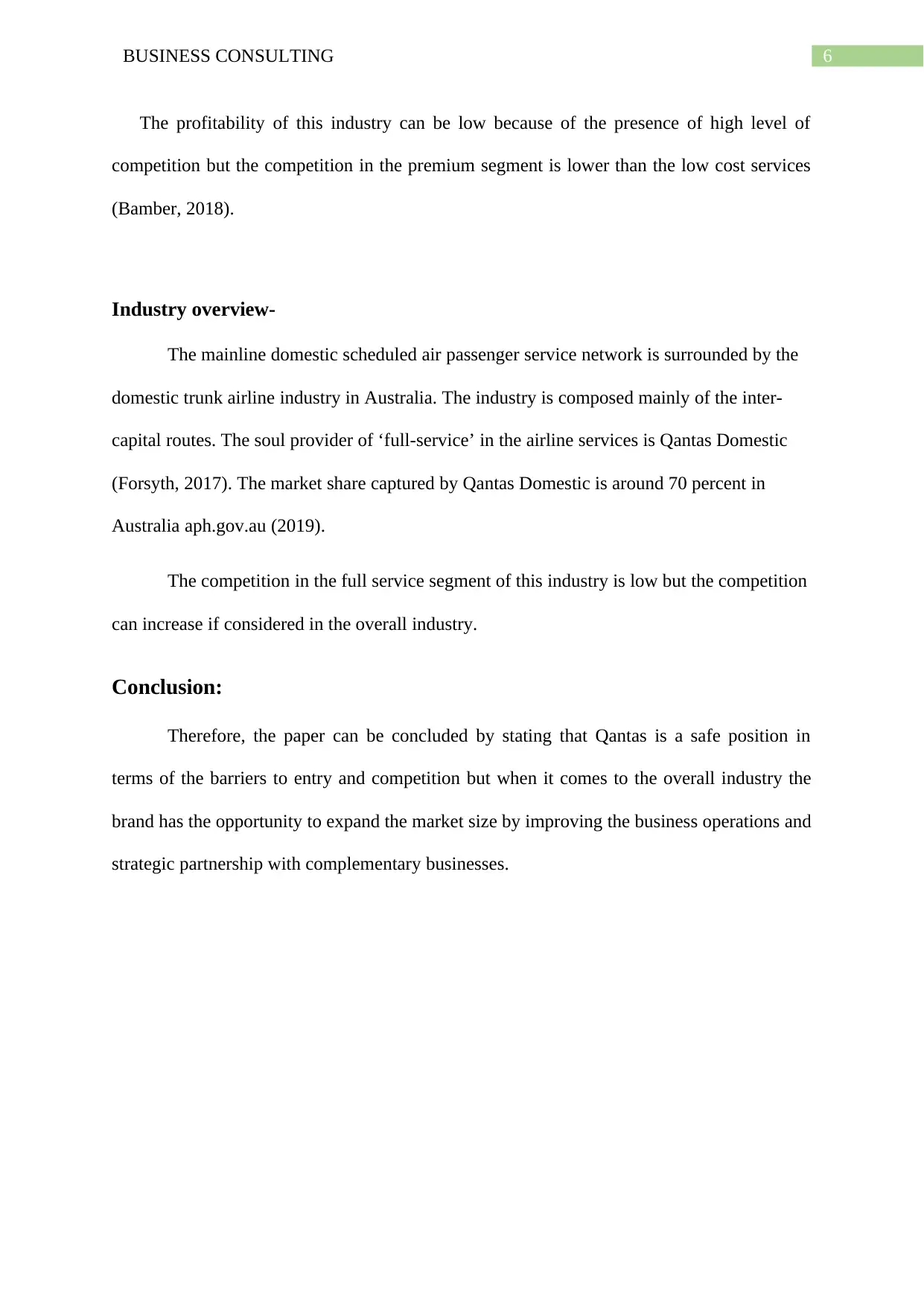
6BUSINESS CONSULTING
The profitability of this industry can be low because of the presence of high level of
competition but the competition in the premium segment is lower than the low cost services
(Bamber, 2018).
Industry overview-
The mainline domestic scheduled air passenger service network is surrounded by the
domestic trunk airline industry in Australia. The industry is composed mainly of the inter-
capital routes. The soul provider of ‘full-service’ in the airline services is Qantas Domestic
(Forsyth, 2017). The market share captured by Qantas Domestic is around 70 percent in
Australia aph.gov.au (2019).
The competition in the full service segment of this industry is low but the competition
can increase if considered in the overall industry.
Conclusion:
Therefore, the paper can be concluded by stating that Qantas is a safe position in
terms of the barriers to entry and competition but when it comes to the overall industry the
brand has the opportunity to expand the market size by improving the business operations and
strategic partnership with complementary businesses.
The profitability of this industry can be low because of the presence of high level of
competition but the competition in the premium segment is lower than the low cost services
(Bamber, 2018).
Industry overview-
The mainline domestic scheduled air passenger service network is surrounded by the
domestic trunk airline industry in Australia. The industry is composed mainly of the inter-
capital routes. The soul provider of ‘full-service’ in the airline services is Qantas Domestic
(Forsyth, 2017). The market share captured by Qantas Domestic is around 70 percent in
Australia aph.gov.au (2019).
The competition in the full service segment of this industry is low but the competition
can increase if considered in the overall industry.
Conclusion:
Therefore, the paper can be concluded by stating that Qantas is a safe position in
terms of the barriers to entry and competition but when it comes to the overall industry the
brand has the opportunity to expand the market size by improving the business operations and
strategic partnership with complementary businesses.
Paraphrase This Document
Need a fresh take? Get an instant paraphrase of this document with our AI Paraphraser
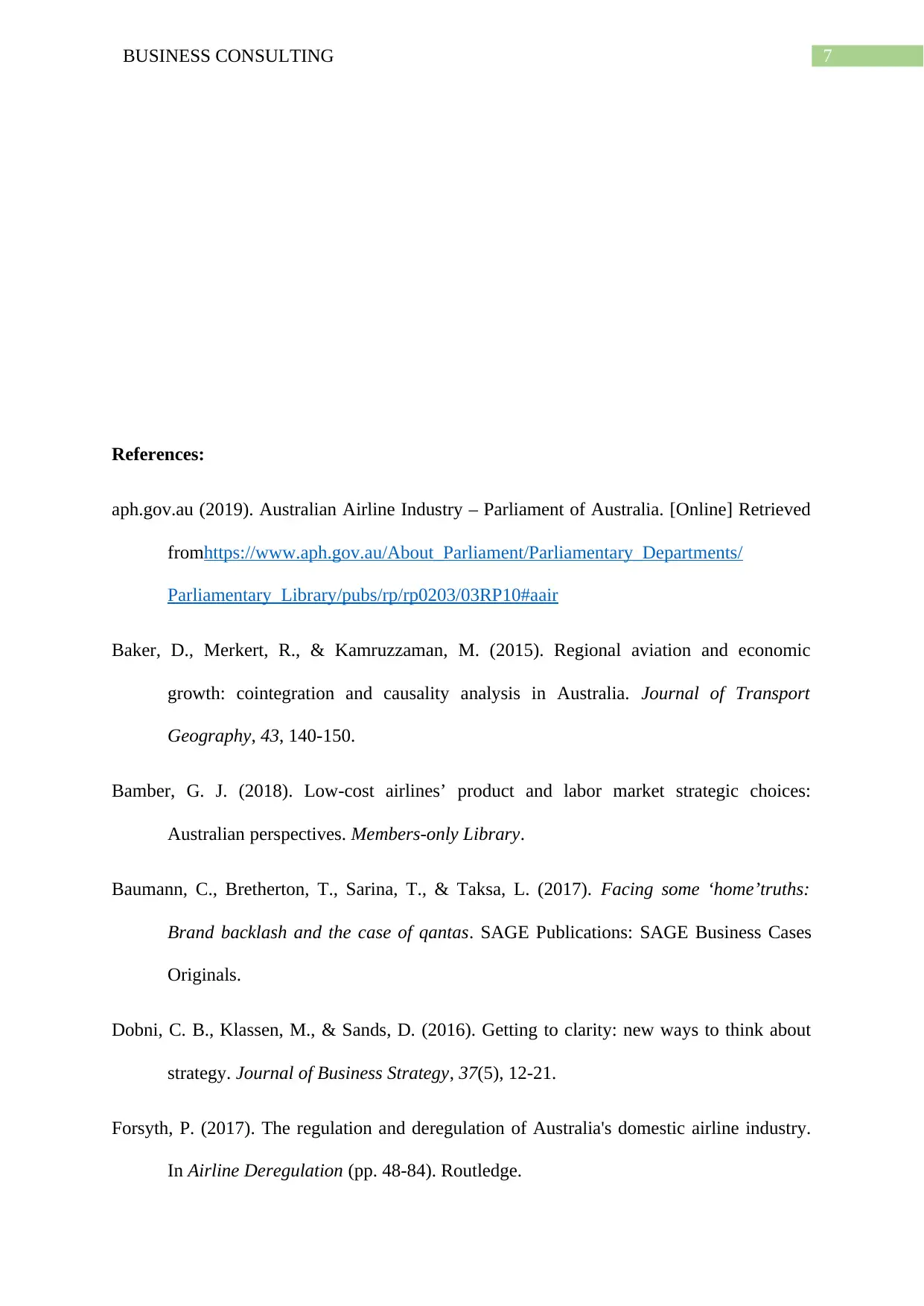
7BUSINESS CONSULTING
References:
aph.gov.au (2019). Australian Airline Industry – Parliament of Australia. [Online] Retrieved
fromhttps://www.aph.gov.au/About_Parliament/Parliamentary_Departments/
Parliamentary_Library/pubs/rp/rp0203/03RP10#aair
Baker, D., Merkert, R., & Kamruzzaman, M. (2015). Regional aviation and economic
growth: cointegration and causality analysis in Australia. Journal of Transport
Geography, 43, 140-150.
Bamber, G. J. (2018). Low-cost airlines’ product and labor market strategic choices:
Australian perspectives. Members-only Library.
Baumann, C., Bretherton, T., Sarina, T., & Taksa, L. (2017). Facing some ‘home’truths:
Brand backlash and the case of qantas. SAGE Publications: SAGE Business Cases
Originals.
Dobni, C. B., Klassen, M., & Sands, D. (2016). Getting to clarity: new ways to think about
strategy. Journal of Business Strategy, 37(5), 12-21.
Forsyth, P. (2017). The regulation and deregulation of Australia's domestic airline industry.
In Airline Deregulation (pp. 48-84). Routledge.
References:
aph.gov.au (2019). Australian Airline Industry – Parliament of Australia. [Online] Retrieved
fromhttps://www.aph.gov.au/About_Parliament/Parliamentary_Departments/
Parliamentary_Library/pubs/rp/rp0203/03RP10#aair
Baker, D., Merkert, R., & Kamruzzaman, M. (2015). Regional aviation and economic
growth: cointegration and causality analysis in Australia. Journal of Transport
Geography, 43, 140-150.
Bamber, G. J. (2018). Low-cost airlines’ product and labor market strategic choices:
Australian perspectives. Members-only Library.
Baumann, C., Bretherton, T., Sarina, T., & Taksa, L. (2017). Facing some ‘home’truths:
Brand backlash and the case of qantas. SAGE Publications: SAGE Business Cases
Originals.
Dobni, C. B., Klassen, M., & Sands, D. (2016). Getting to clarity: new ways to think about
strategy. Journal of Business Strategy, 37(5), 12-21.
Forsyth, P. (2017). The regulation and deregulation of Australia's domestic airline industry.
In Airline Deregulation (pp. 48-84). Routledge.
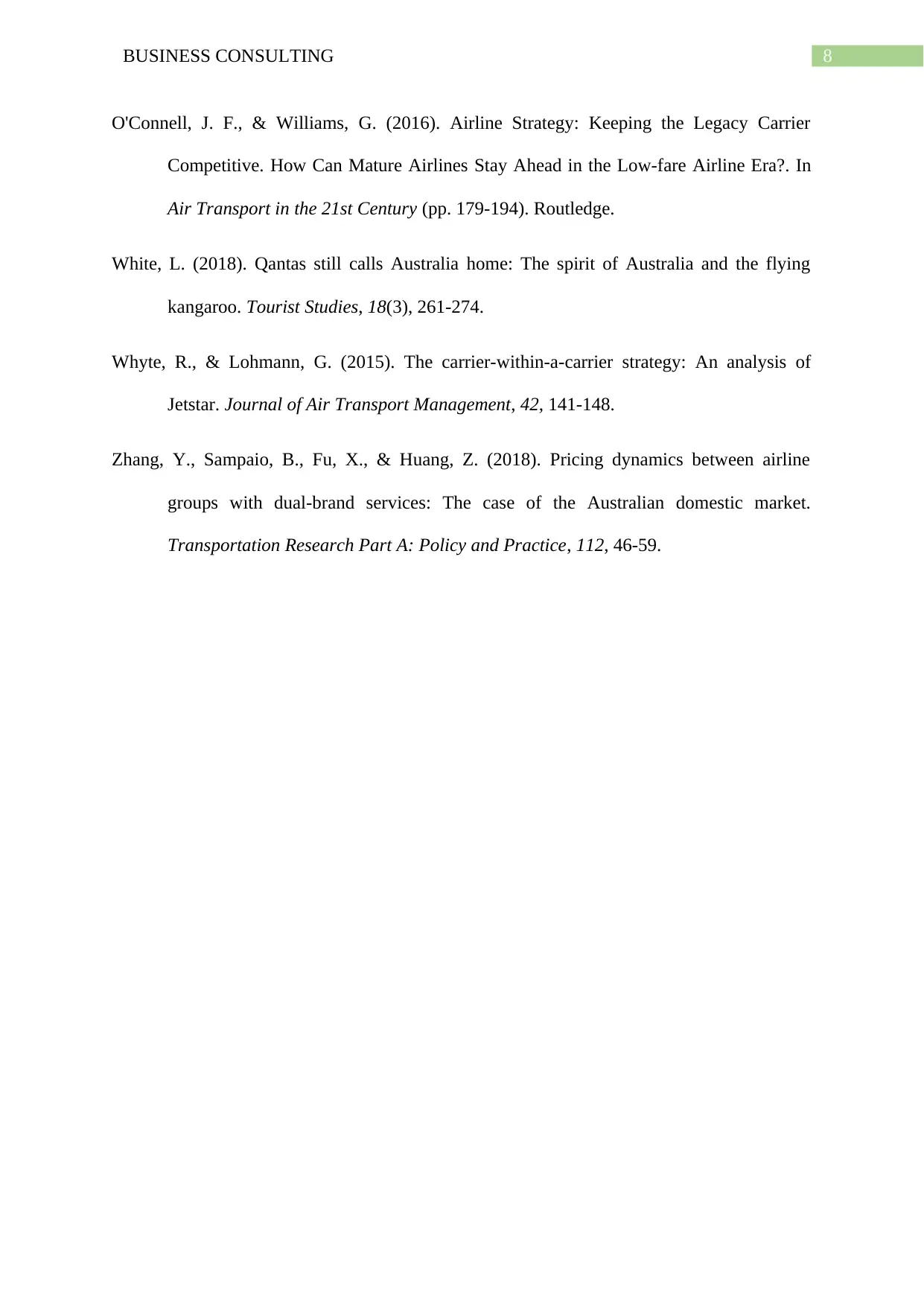
8BUSINESS CONSULTING
O'Connell, J. F., & Williams, G. (2016). Airline Strategy: Keeping the Legacy Carrier
Competitive. How Can Mature Airlines Stay Ahead in the Low-fare Airline Era?. In
Air Transport in the 21st Century (pp. 179-194). Routledge.
White, L. (2018). Qantas still calls Australia home: The spirit of Australia and the flying
kangaroo. Tourist Studies, 18(3), 261-274.
Whyte, R., & Lohmann, G. (2015). The carrier-within-a-carrier strategy: An analysis of
Jetstar. Journal of Air Transport Management, 42, 141-148.
Zhang, Y., Sampaio, B., Fu, X., & Huang, Z. (2018). Pricing dynamics between airline
groups with dual-brand services: The case of the Australian domestic market.
Transportation Research Part A: Policy and Practice, 112, 46-59.
O'Connell, J. F., & Williams, G. (2016). Airline Strategy: Keeping the Legacy Carrier
Competitive. How Can Mature Airlines Stay Ahead in the Low-fare Airline Era?. In
Air Transport in the 21st Century (pp. 179-194). Routledge.
White, L. (2018). Qantas still calls Australia home: The spirit of Australia and the flying
kangaroo. Tourist Studies, 18(3), 261-274.
Whyte, R., & Lohmann, G. (2015). The carrier-within-a-carrier strategy: An analysis of
Jetstar. Journal of Air Transport Management, 42, 141-148.
Zhang, Y., Sampaio, B., Fu, X., & Huang, Z. (2018). Pricing dynamics between airline
groups with dual-brand services: The case of the Australian domestic market.
Transportation Research Part A: Policy and Practice, 112, 46-59.
⊘ This is a preview!⊘
Do you want full access?
Subscribe today to unlock all pages.

Trusted by 1+ million students worldwide
1 out of 9
Related Documents
Your All-in-One AI-Powered Toolkit for Academic Success.
+13062052269
info@desklib.com
Available 24*7 on WhatsApp / Email
![[object Object]](/_next/static/media/star-bottom.7253800d.svg)
Unlock your academic potential
Copyright © 2020–2025 A2Z Services. All Rights Reserved. Developed and managed by ZUCOL.





